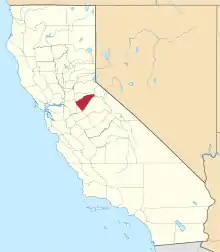Greasertown, California
Greasertown (also, Petersburg) is a former settlement in Calaveras County, 4 miles (6.4 km) west of San Andreas, on the west side of the Calaveras River.[1] The town was rumored to have received its name due to what one-time resident and schoolteacher Margaret Blanc described as “a straggling settlement … with canvas tents and wooden shanties of which it consisted the abodes of … Mexicans who packed and drove mules up to the mines with provisions for the diggers at work on the banks on the Mokelumne and Calaveras.” Blanc said the town was in fact diverse, with many nationalities represented. She wrote that the town included, “About 30 children made up of all classes, nationalities and ages.”
According to “Grizzly Bear” author J. Rush Bronson, in the late 1850s, Petersburg boasted a population of approximately 200 Chinese immigrants mining the river bars on the Calaveras River and 25 white men. Bronson tells a tale of a miner-style battle. The Chinese and white miners “came in conflict with each other May 15 over control of a dam, the white miners fighting to maintain it and the Chinamen to destroy it. The battle lasted over an hour and was fought with rocks, clubs and shovels. About a score of Chinamen were disabled, some being seriously hurt and after being driven off they had the white men arrested for battery.”
The history of the Gold Rush in the Mother Lode contains repeated records of the sometimes violent abhorrence of “foreign” miners. Petersburg was destroyed by fire on Sept. 14, 1852. Some in the town accused Mexican and Chilean nationals of causing the fire. An article titled “Expulsion” that ran in the Daily Alta California on Sept. 20, 1852, fanned the dying embers to create yet another type of inferno.
“The destruction of (Petersburg) by the Spanish incendiaries so incensed the miners living around Latimore’s Ranch and Mr. Lake’s store, on the Calaveras, that they formed themselves into a company with the determination to drive away every Mexican or Chilean they could find. Accordingly, on Monday they marched to the camp, as we are informed, and expelled, a la force, several hundred of what had composed the population of a large portion of Greasertown. Our informant states that this place was the headquarters of a desperate band of murderers and thieves and that they here concocted many of the fiend-like schemes which, after having been consummated, have excited the horror and animosity of our whole community. Several of these thieves who were recognized were flogged.”
The miners at Vallecito held a meeting and passed resolutions to compel the Spanish-speaking population to leave in 12 hours. The article continued, “From appearances, it seems the Americans in Calaveras and Tuolumne counties are determined to rid themselves of the Spanish American people. It may occasion considerable bloodshed.” Fire once again consumed a large portion of Petersburg in early July 1854. The Sonora Herald covered the story.
“A fire broke out in our city about half past 9 o’clock, originating in a frame building on the corner of Holden and Lyons Street, in the quarter generally called Greasertown … the flames spread quickly … the hook and ladder and hose companies were on the ground quickly, and what with their efforts and the individual exertions of citizens throwing water on the houses … we were saved from total destruction … about 12 buildings were destroyed …”
Petersburg remained racially divided for many years to come. An entry in the Daily Alta California News for Nov. 19, 1857, reported, “The portion of the city known as ‘Greasertown’ is overrun at the present time with a set of desperate characters disturbing the quiet of respectable citizens who are unfortunate enough to reside in that locality.”
At times, however, Petersburg residents showed a more philanthropic side. The Marin Journal of Oct. 18, 1862, reported that a relief fund for sick and wounded soldiers sent east by the Sanitary Committee of San Francisco included a contribution from Calaveras County. “A little town in Calaveras County, with only about 50 voters, contributes $404; the name of this philanthropic place is Greasertown.”
After the heavy rains of 1907, residents of flood-ravaged Stockton sought to dam the Calaveras River to prevent further flooding. The condemnation of Petersburg was completed on June 25, 1924, clearing the way for the first dam on the Calaveras River. The dam flooded the old mining town under 115,000 acre feet of water when it was completed in 1930. It is named for Walter Byron Hogan, one time engineer and city manager for Stockton.[2]
References
- Durham, David L. (1998). California's Geographic Names: A Gazetteer of Historic and Modern Names of the State. Clovis, Calif.: Word Dancer Press. p. 824. ISBN 1-884995-14-4.
- Maness, Charity (2015) “Petersburg stood in zone inundated by old Hogan dam.” Calaveras Enterprise Nov. 2015. Accessed December 31, 2015 from: http://www.calaverasenterprise.com/news/article_91f4ef1a-87c9-11e5-bb0c-97d17765d470.html 2015
